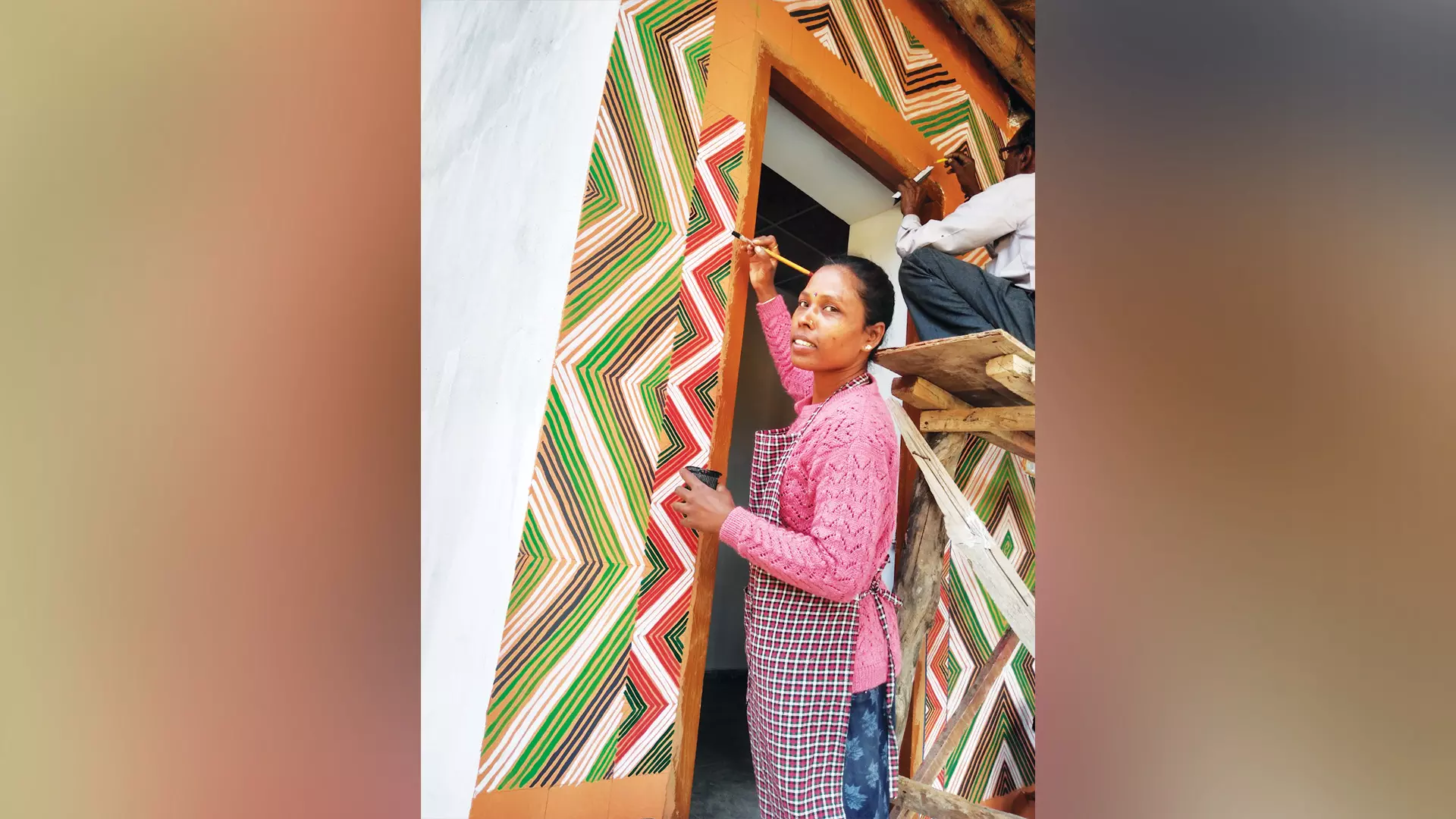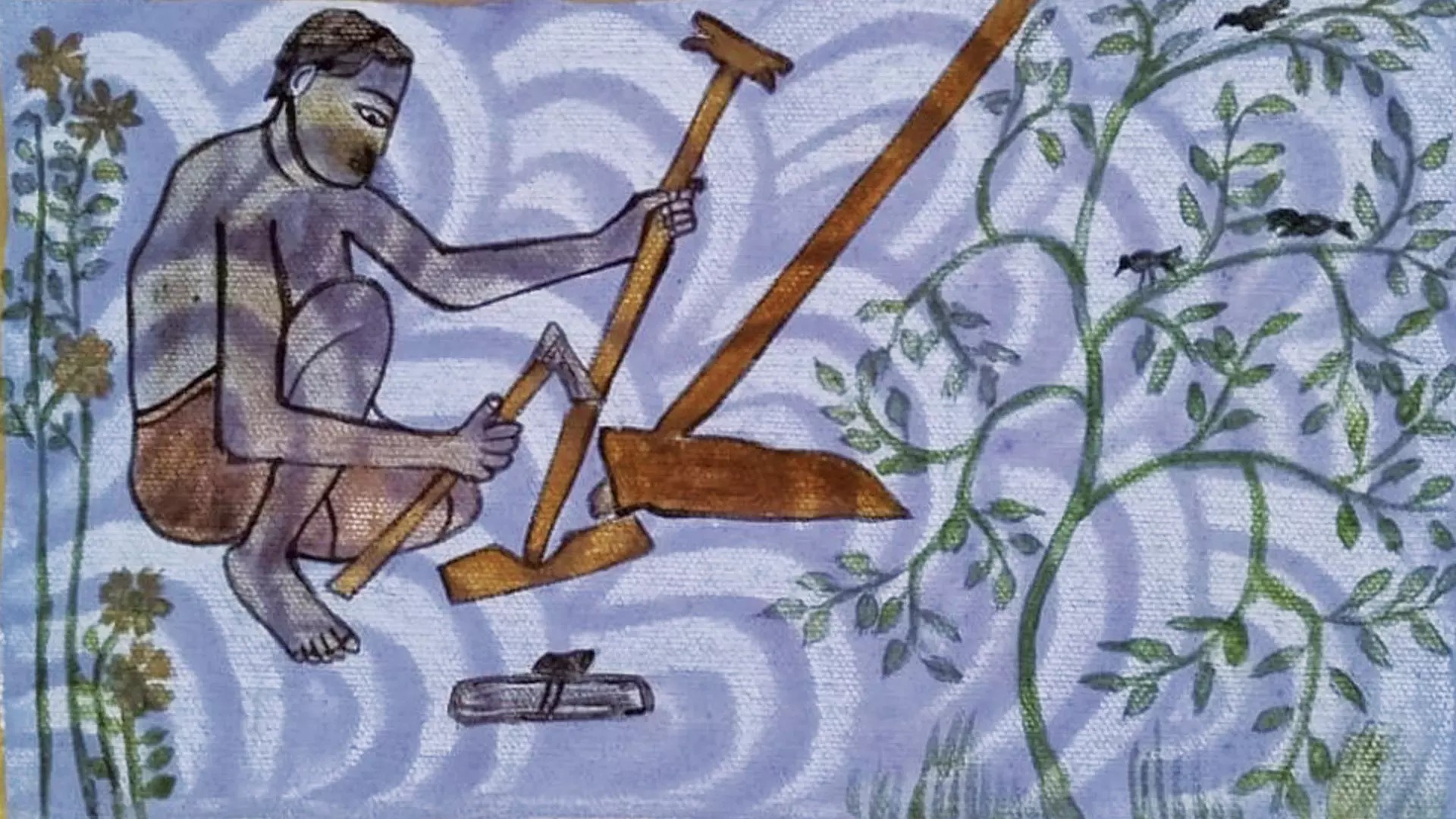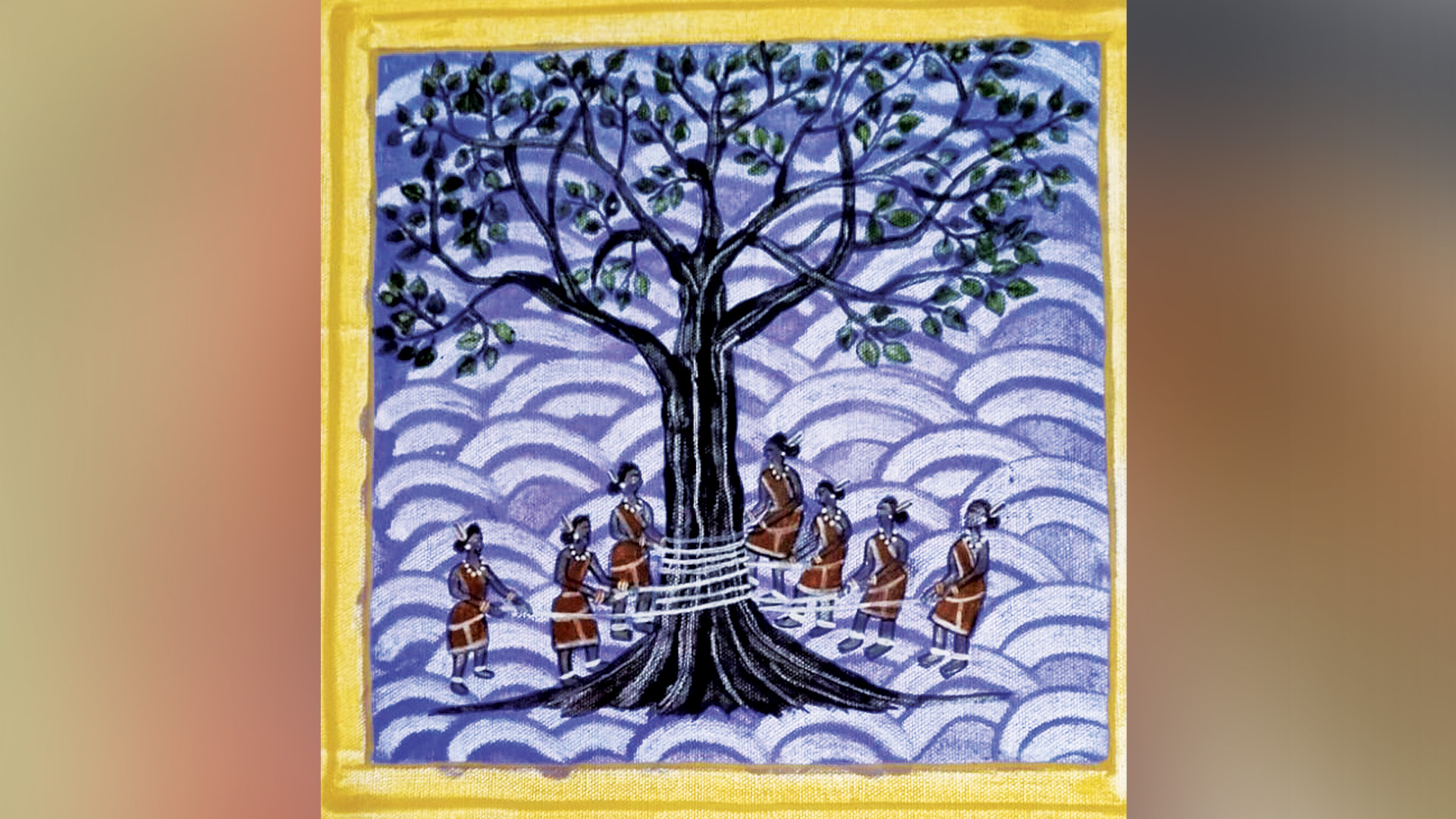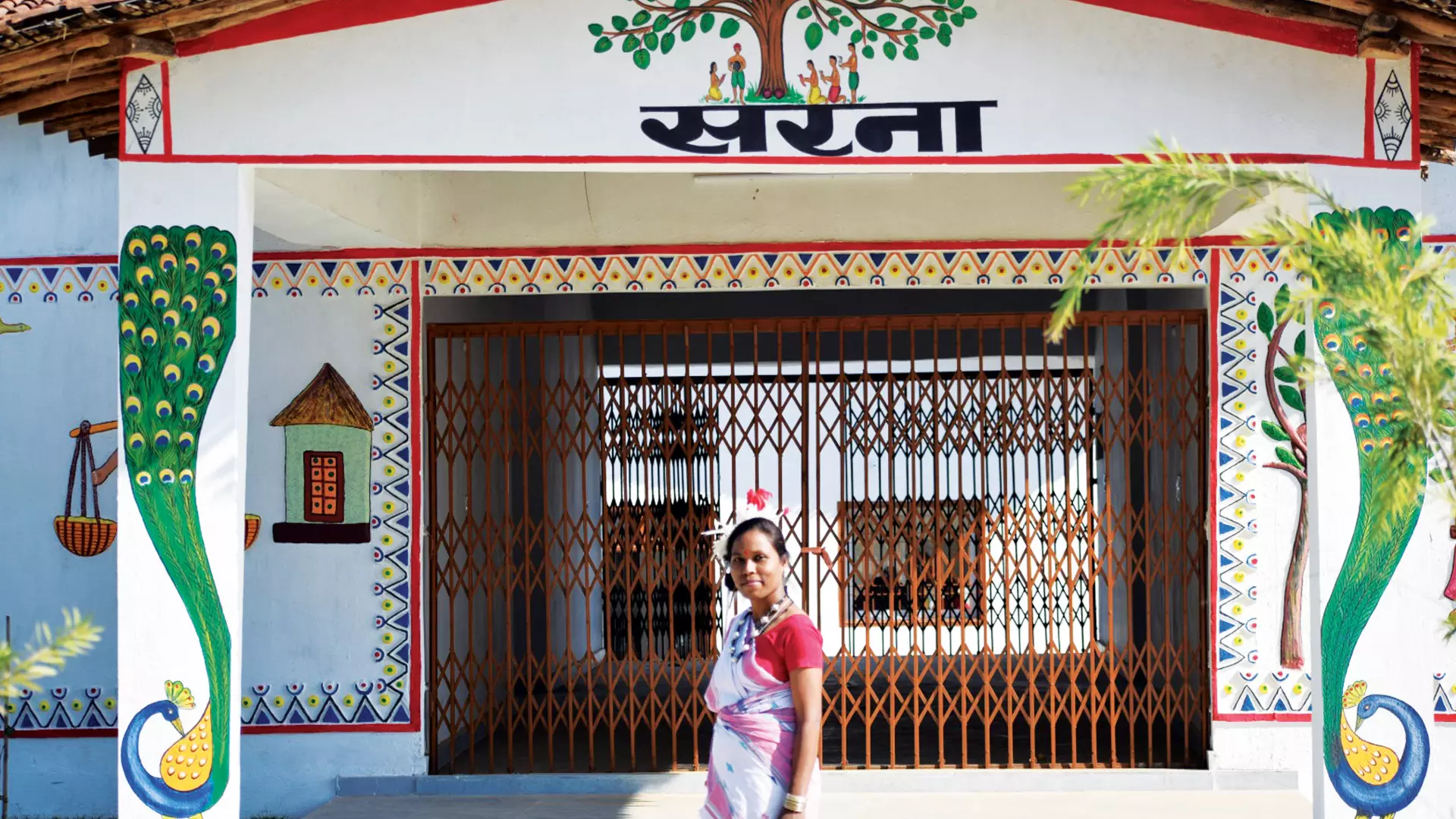
- Home
- India
- World
- Premium
- THE FEDERAL SPECIAL
- Analysis
- States
- Perspective
- Videos
- Sports
- Education
- Entertainment
- Elections
- Features
- Health
- Business
- Series
- In memoriam: Sheikh Mujibur Rahman
- Bishnoi's Men
- NEET TANGLE
- Economy Series
- Earth Day
- Kashmir’s Frozen Turbulence
- India@75
- The legend of Ramjanmabhoomi
- Liberalisation@30
- How to tame a dragon
- Celebrating biodiversity
- Farm Matters
- 50 days of solitude
- Bringing Migrants Home
- Budget 2020
- Jharkhand Votes
- The Federal Investigates
- The Federal Impact
- Vanishing Sand
- Gandhi @ 150
- Andhra Today
- Field report
- Operation Gulmarg
- Pandemic @1 Mn in India
- The Federal Year-End
- The Zero Year
- Science
- Brand studio
- Newsletter
- Elections 2024
- Events
Weaved in mud and leaves, how an Oraon artist is trying to preserve her language and rituals

Forest deities, sun, stars, birds and rituals… If you ask Sumanti Bhagat, a tribal artist belonging to the Oraon (Kurukh) community, where she gets the inspiration from, she will point at the forest. For Sumanti, the forest is the source of everything that she inherited and possesses. Born in a remote village called Shaila at Jashpur in Chhattisgarh, Sumanti is not an artist who grew up...
Forest deities, sun, stars, birds and rituals… If you ask Sumanti Bhagat, a tribal artist belonging to the Oraon (Kurukh) community, where she gets the inspiration from, she will point at the forest. For Sumanti, the forest is the source of everything that she inherited and possesses. Born in a remote village called Shaila at Jashpur in Chhattisgarh, Sumanti is not an artist who grew up with the promotion of social organisations because of being a member in a marginalised community. There was a fire in her as a child, and as she grew up, she started showing interest in listening to the myths and legends of the Oraon community, an oral tradition of story-telling transferred through generations since there are no written or recorded texts for the community. She would listen to her parents when they narrated the stories, many of which are directly associated with the way of living and the belief system of the Oraon community.
Like many tribal communities in India, the Oraon people also paint the walls of their homes with ethnic designs and patterns once every year. Sumanti got the basics of how to do the wall painting from her grandmother and mother. For most children her age, it was an annual affair. But Sumanti tried to reproduce the myth and legends that she heard from her parents and grandparents through art round the year. A community exhibition of tribal artists, held in Khajuraho, was a turning point. Today, Sumanti has exhibited her works in many major towns and cities in India. She has been working hard to promote her community's language, Kurukh, rituals and customs through her works, using charcoal, green leaves and red clay.

Sumanti Bhagat says she gets her inspiration from the forests around which she has grown up.
The Oraon are a Dravidian speaking ethnolinguistic community found in Jharkhand, Odisha, Chhattisgarh and West Bengal. They speak Kurukh, a language which belongs to the Dravidian family. “I use natural pigments and make paints from natural sources,” says Sumanti, who now lives in Bhopal. Sumanti uses three shades of mud—black, red and yellow—available in the forests of the region. Besides, charcoal and green leaves are used as natural pigments. “The painting is done using the fingers dipped in mud, and a brush is used to define the outline. The themes are largely around tribal festivals and rituals. I also make good luck paintings, forest deities, sun, moon and Danda Kattna or Dharmesh pooja which is performed on auspicious occasions,” says the 43-year-old spinster, who didn’t have time to get married as she was in search of stories from the elders in the community. “We have a rich history of stories based on myths as well as legends. They are being passed on from generation to generation. When my friends got married, I was busy searching for stories from our elders,” she added.
The Oraon community paints the walls of their homes once every year. What they paint represents their gotra or sub caste, says Lily Bhavna Kauler, of Capre Foundation, a self-funded NGO, which has been working with Oraon tribes since 1990. “There are 12 gotras that are represented by different creatures. For example, the tiger is for the Lakra gotra, the ‘tirkhai’ bird for the Tirkey gotra, fish for the Minj gotra, and tortoise for the Kachhap gotra,” she tells The Federal. Lily Bhavna Kauler recently curated an exhibition of the paintings done by Sumanti in Chandigarh, which evoked a great response.

A work created by Sumanti. People of the Oraon community paint the walls of their homes once every year.
The Oraons are followers of Sarna religion. Sarnaism or Sarna defines the indigenous religions of the tribal people of Jharkhand, such as the Santal, Oraon, Munda, Ho and the others, where Sarna means sacred grove, according to Mukul Bara, a research scholar at Banaras Hindu University, Varanasi. “The religious beliefs and practices of Oraons are centred around one supreme god, known as Dharmes and they invoke his blessings before all important occasions. Apart from the faith in the Dharmes, the Oraons believe in ancestral spirits and numerous other benevolent and malevolent spirits,” writes Mukul Bara in his paper titled ‘Ethnographic Study of Oraon Tribe of Lodhma Village, Jharkhand’ published in IOSR Journal of Humanities and Social Science.
The Oraons are the tribes of the Chota Nagpur Plateau (covers Jharkhand, Chhattisgarh, Odisha, Bihar and West Bengal) in eastern India. However, it is believed that their original home was in the Konkan region if one goes by the legends and traditional sources of the Oraons.
“Many Scholars like E Dalton (1872), P Dehon (1906), RO Dhan (1967), SC Roy (2004), view that because of overpopulation and external pressure they migrated from the west coast India to northern India travelling through river valleys and reached the Rohtasgarh in Shahabad district of Bihar and settled down there as agriculturists, around 800 BC,” he writes.
“The life of Oraons in Rohtasgarh has been peaceful and prosperous. Then again they were forced to immigrate from Rohtasgarh to different parts of Chotanagpur and when they left Rohtasgarh the Oraons split up into two groups. The first group who left the place perhaps were the Berge or Berga Oraon, who occupied the state of Gangpur. Other groups of Oraons, known as Male, are eventually settled in the Rajmahal hills and are also found in the Plateau of Chota Nagpur are usually known as Oraons,” he added. Besides these, the other groups of Oraons such as Dhangars, Koras and Kisans are also found in different parts of the state like Bihar, West Bengal, Orissa, Chattisgarh, Madhya Pradesh and Maharashtra.

An art work created by Sumanti.
Lily started working with Sumanti about 10 years ago. “She (Sumanti) promotes her language, culture and stories and art to other Oraon people who, due to displacement, have lost a lot of the rich culture they once had. I have been assisting Sumanti to first research, then put together in a plain and easy language lost Oraon stories and then make art of that story. I am doing this with Oraon stories as I have done in Australia with the Aboriginal people,” says Lily.
Sumanti feels there is a cultural vacuum in her community mainly due to migration and lack of employment. The number of people who speak their mother tongue Kurukh has come down as people in the community have adapted to Nagpuri (Sadri), an Indo-Aryan language spoken in Jharkhand, Chhattisgarh, Bihar and Odisha. Many Oraons who work in the tea estates of West Bengal, Assam and Tripura use Nagpuri as a link language to communicate.
“I speak to people of the community in Kurukh only. I think the more you speak a language, the more it grows. Our customs and practices are interwoven with our language. If we don’t preserve it, then we will lose it soon. I am trying my level best to create awareness among people in our community to speak Kurukh,” said Sumanti. As a language, Kurukh didn’t have a script. It was Narayan Oraon, a physician in Jharkhand, who developed an alphabetic script called Talong Siki for Kurukh in the late 1990s. In 2006, the Kurukh Literary Society was launched to promote the language and culture of the community.

Sumanti’s works are not just a replica of the elements that she comes across. She redefines the ancestral connection with nature, focusing on Oraon’s traditional folk ideas, customs, and rituals. There are birds, animals, trees and people depicted on the walls but each one has a story behind it. They reflect the challenges that the tribal artist faces when it comes to preserving her community’s language and culture. Even though Sumanti’s works captured the spirit of the Oraon community, she was not able to sell her works in the beginning.
“One of the main problems that Sumanti has faced is not having the marketing networks and lack of knowledge in digital marketing, areas in which I am now filling the gap. Sumanti attends several exhibitions-cum-sales events in various cities but the awareness about Oraon art is still very little due to this sales are not impressive. I am working on an international exhibition currently. One of the upcoming exhibitions is in Siliguri on March 15, 2024 in which Sumanti will get an award,” says Lily.
